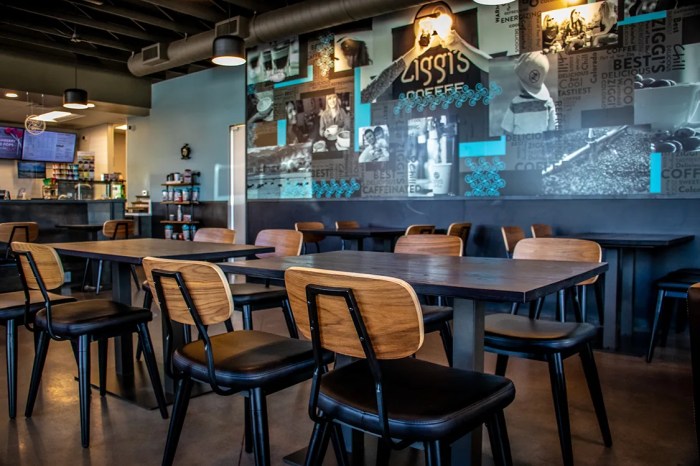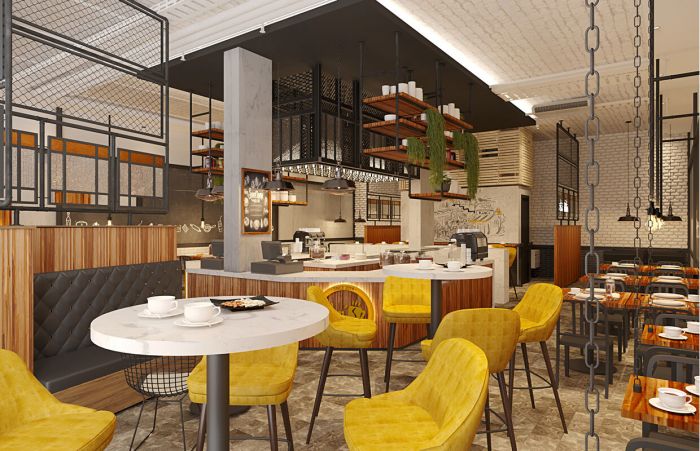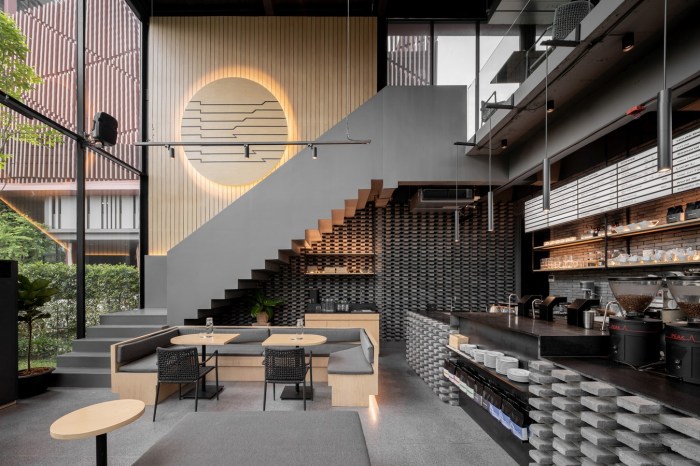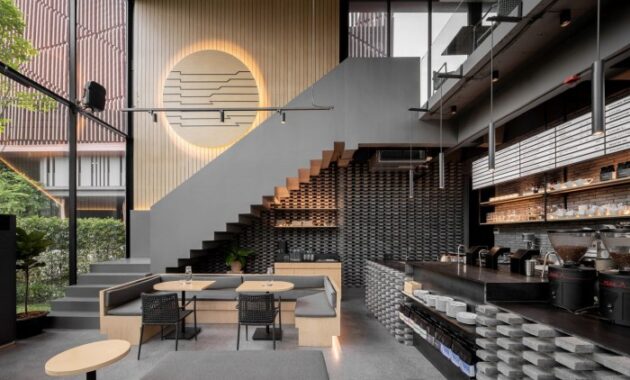Coffee house interior design photos offer a captivating glimpse into spaces that blend functionality with aesthetics, creating inviting environments where coffee lovers can relax and socialize. From the warm embrace of rustic charm to the sleek modernity of minimalist designs, each coffee house interior tells a unique story through its furniture, color palettes, lighting, and materials.
These photos showcase the artistry of design, inspiring us to envision our own ideal coffee house havens.
This exploration delves into the key elements of coffee house interior design, examining different styles, layouts, color schemes, and materials. We’ll uncover the secrets behind creating a welcoming and functional space that caters to the diverse needs of coffee enthusiasts.
Whether you’re a coffee shop owner seeking inspiration or simply a design aficionado, these photos provide a wealth of ideas and insights into the world of coffee house interiors.
Coffee House Interior Design Lighting: Coffee House Interior Design Photos

The lighting in a coffee house is crucial in creating the right ambiance and atmosphere, influencing customer experience and setting the overall tone. It plays a vital role in shaping how customers perceive the space, impacting their mood, comfort, and ultimately, their desire to linger.
Types of Lighting
The choice of lighting in a coffee house should be carefully considered, taking into account the desired ambiance, the functionality of the space, and the overall design aesthetic.
- Natural Light: Natural light is essential for creating a welcoming and inviting atmosphere. Large windows, skylights, and open spaces can flood the coffee house with natural light, making it feel bright, airy, and spacious. It also provides a sense of connection with the outdoors, which can be particularly appealing during the day.
However, it’s important to manage the amount of natural light to prevent glare or excessive heat.
- Ambient Light: Ambient light provides overall illumination, creating a general sense of brightness and visibility. It is typically achieved through ceiling fixtures, such as chandeliers, pendant lights, or recessed lighting. Ambient lighting should be soft and diffused, creating a warm and inviting atmosphere without being too harsh or bright.
- Task Lighting: Task lighting is designed to provide focused illumination for specific activities, such as reading, working, or using a laptop. This type of lighting is typically placed near seating areas, tables, or workspaces, using desk lamps, table lamps, or track lighting.
Task lighting should be bright enough to provide adequate visibility without creating glare or shadows.
- Accent Lighting: Accent lighting is used to highlight specific features or objects, adding visual interest and depth to the space. This can include highlighting artwork, architectural details, or even showcasing the coffee brewing process. Accent lighting can be achieved using spotlights, wall sconces, or even LED strips, creating a dramatic effect and enhancing the overall design aesthetic.
Examples of Lighting Techniques
- Highlighting Architectural Features: Accent lighting can be used to highlight architectural features, such as exposed brick walls, vaulted ceilings, or unique architectural details. This can create a sense of depth and dimension, drawing attention to the design elements and enhancing the overall aesthetic.
- Creating Intimacy: Dim lighting can create a sense of intimacy and coziness, making the coffee house feel inviting and relaxing. This can be achieved using soft ambient lighting, table lamps, or even candlelight. Intimate lighting is particularly effective in creating a romantic atmosphere, making it ideal for evening gatherings or dates.
- Enhancing the Overall Design: Lighting can be used to enhance the overall design aesthetic of the coffee house. For example, using warm-toned lighting can create a welcoming and inviting atmosphere, while cooler-toned lighting can create a more modern and sophisticated feel. Lighting can also be used to create different moods and atmospheres within the space, depending on the desired effect.
Coffee House Interior Design Sustainability

Sustainability is a crucial aspect of coffee house design, as it not only benefits the environment but also enhances the brand image and attracts environmentally conscious customers. By incorporating sustainable design practices, coffee houses can reduce their environmental footprint and contribute to a more sustainable future.
Sustainable Materials and Finishes, Coffee house interior design photos
Sustainable materials and finishes play a vital role in creating eco-friendly coffee house interiors. These materials are sourced responsibly and minimize environmental impact throughout their lifecycle.
- Recycled Materials:Utilizing recycled materials, such as reclaimed wood, repurposed furniture, and recycled glass, reduces waste and promotes resource conservation. For example, using reclaimed wood for flooring and furniture adds character and sustainability to the coffee house.
- Renewable Resources:Incorporating renewable resources, such as bamboo, cork, and sustainable timber, reduces reliance on non-renewable materials. Bamboo is a rapidly growing and sustainable material that can be used for flooring, furniture, and wall panels.
- Energy-Efficient Lighting:Implementing energy-efficient lighting solutions, such as LED lights, reduces energy consumption and lowers operational costs. LED lights are long-lasting, energy-saving, and emit less heat than traditional incandescent bulbs.
Closure

By immersing ourselves in the world of coffee house interior design photos, we gain a deeper appreciation for the artistry and intentionality that goes into creating these inviting spaces. From the carefully chosen furniture to the strategically placed lighting, every detail contributes to the overall ambiance and experience.
As we explore these photos, we’re not just admiring the aesthetics; we’re also gaining valuable insights into the principles of design, the psychology of color, and the importance of creating a welcoming and functional environment. Whether you’re a coffee enthusiast or a design enthusiast, these photos offer a glimpse into the world of coffee house design and its enduring appeal.
FAQ Overview
What are the most common coffee house interior design styles?
Popular styles include modern, industrial, rustic, minimalist, and bohemian. Each style has distinct characteristics in terms of furniture, color palettes, lighting, and materials.
How important is lighting in coffee house interior design?
Lighting plays a crucial role in creating the desired atmosphere. Natural light, ambient light, task lighting, and accent lighting can all be used to enhance the space and highlight specific features.
What are some sustainable materials used in coffee house interiors?
Sustainable options include recycled materials, renewable resources like bamboo and reclaimed wood, and energy-efficient lighting.
What are some emerging trends in coffee house interior design?
Trends include biophilic design (incorporating natural elements), smart technology for automation, and flexible spaces that can adapt to different needs.

